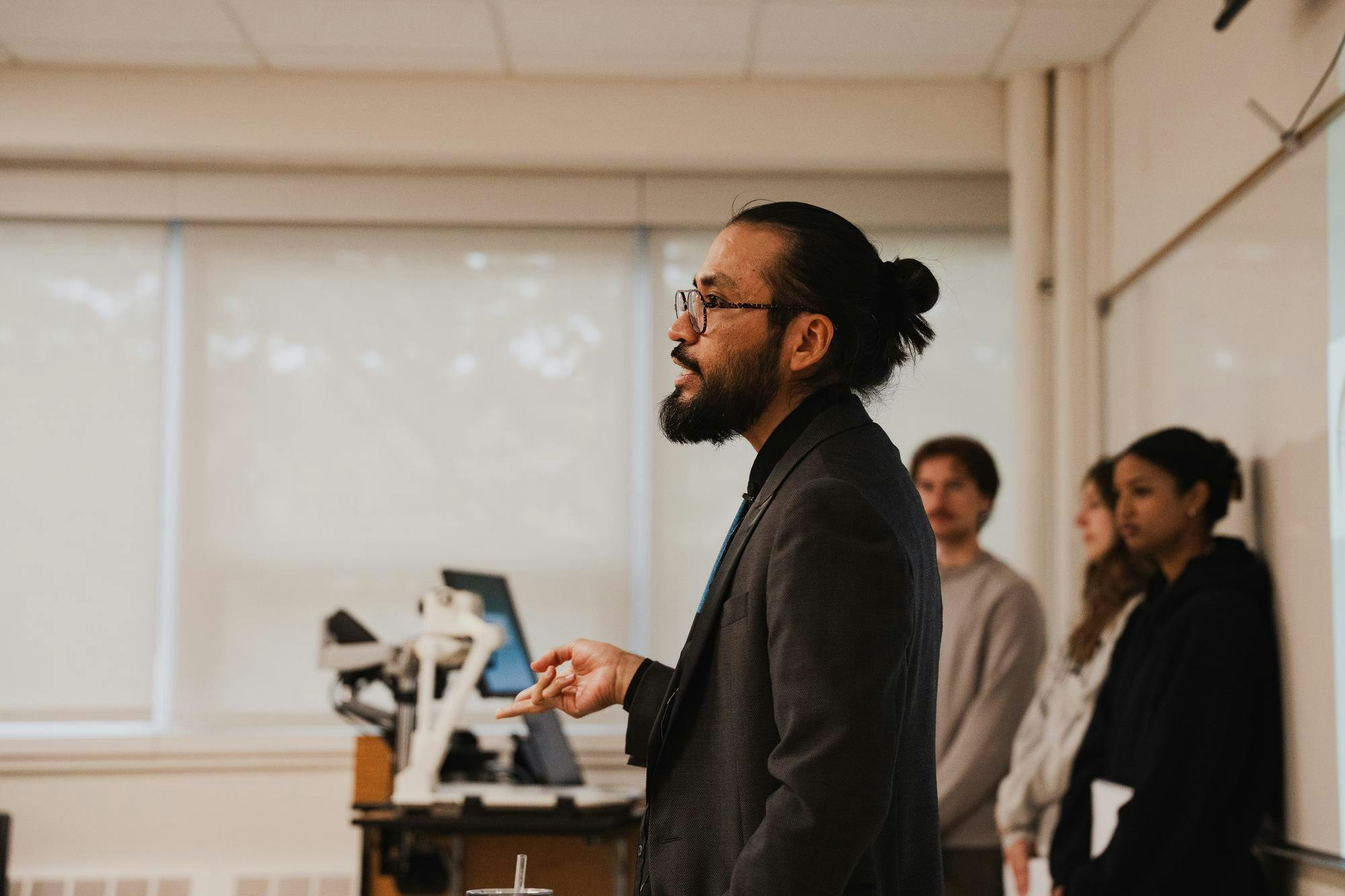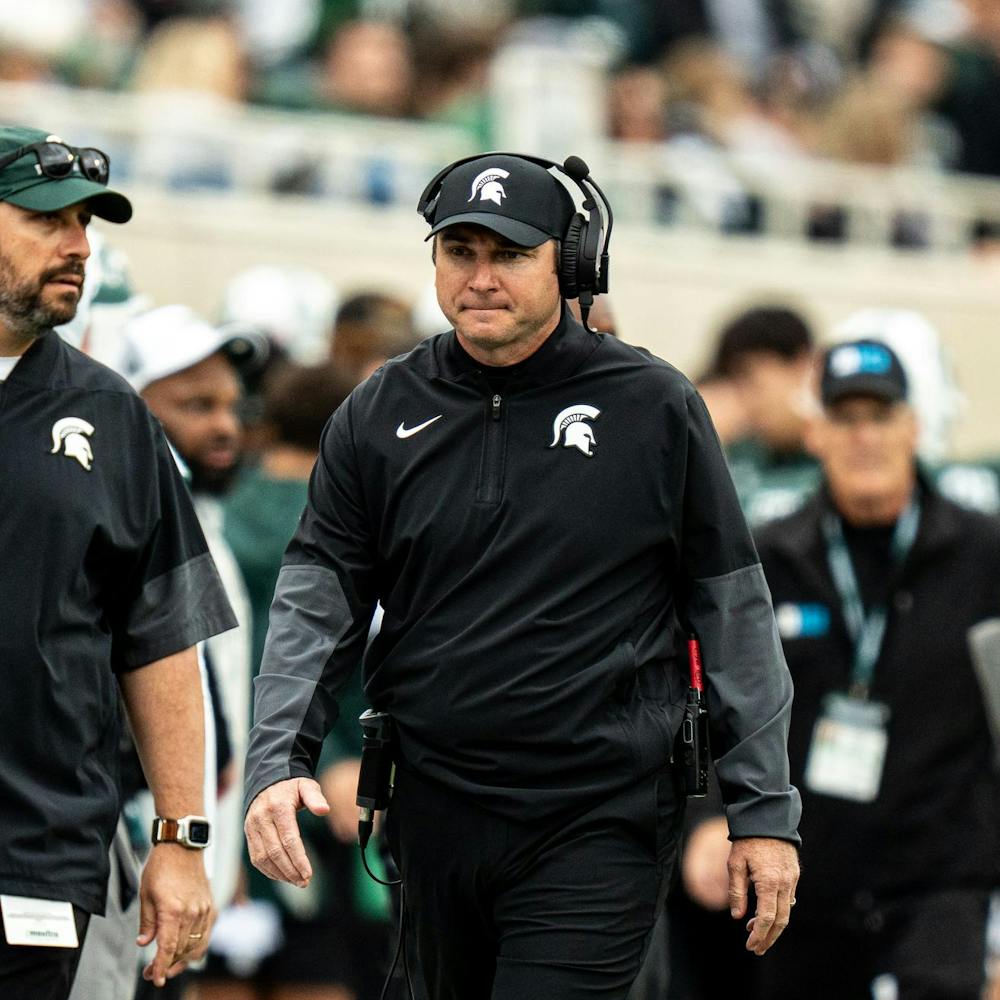If you’re unfamiliar with the term, you’re not alone — it’s one Mendoza-Cortes coined himself.
The title answers a question that many have never considered: What do you call a scientist who combines multiple disciplines, such as physics, chemistry, engineering and mathematics? Mendoza-Cortes felt the traditional labels didn’t quite capture his work, so he created one. And thus, the term "renaissance scientist" came to be.
Mendoza-Cortes paves his way at Michigan State as a professor and researcher in quantum mechanics working in a laboratory named after himself on clean energy applications — all in a second language.
Following his interests
Mendoza-Cortes said he has always had a natural desire to learn but was the first in his family to pursue a scientific career.
“Growing up, I really didn't have a scientist nearby, nor an engineer,” Mendoza-Cortes said.
He began his search for knowledge as a child. Though he didn’t quite know what a scientist was, he decided to “go with the flow” and follow his interests and passions. That mindset has guided his life, he recounted as an adult.
Growing up in Mexico, Mendoza-Cortes spent his time in school participating in academic competitions at local and national levels. In sixth grade, Mendoza-Cortes earned presidential recognition after receiving one of the highest scores in the Academic Olympics for his work.
While he works in English today, it is not the scientist's first language. Until the age of 18, he only spoke and worked in Spanish.
After childhood, Mendoza-Cortes continued his education at the Monterrey Institute of Technology and Higher Education in Monterrey, Mexico, where he earned his Bachelor of Science degree in chemistry and physics.
During his time there, he participated in a program that allowed him to complete part of his degree at the University of California, Los Angeles. He then went on to the California Institute of Technology, where he received both his Master of Science degree and Ph.D. in physics.
It was at that point that Mendoza-Cortes realized he could make a career out of following his interests and passions.
"It opened my mind, you know? I didn't know that that existed or could be a viable path," Mendoza-Cortes said. "In my early twenties, at the end of my college career, I realized that you could actually do this for a living."
In 2015, Mendoza-Cortes started a position at Florida State University where he worked in physics, scientific computing, and chemical and biomedical engineering. He taught in computational methods for engineering and graduate mathematics.
During this time, he introduced, developed and taught the university’s first ever classes in quantum computing and machine learning. He was at the university for five years before leaving the position in 2020.
Mendoza-Cortes said he never envisioned himself becoming a professional educator. Like many things, the teaching positions at FSU and MSU found him as he pursued his passions and "went with the flow."
In retrospect, he said he has always been a teacher, as he taught his peers and classmates what he learned along the way.
"All that experience of trying to understand something, I would then explain it to others, I have been doing that as far back as I can think," Mendoza-Cortes said. "So, I thought, 'Oh, that's actually teaching.'"
Support student media!
Please consider donating to The State News and help fund the future of journalism.
When working in such niche and complex fields, he said the amount of people you can converse with about your work is small. To teach a student is to make that pool of knowledge and conversation partners larger.
"You just have very few people you can talk with about things, and they will understand you, and so it's pretty rewarding to personally make that pool a little bigger," Mendoza-Cortes said.
It was in his teaching position at FSU that he met his future research assistant and long-time collaborator Austin Rodriguez, who was then an undergraduate studying chemical engineering and taking a class Mendoza-Cortes taught on chemical engineering computations.
Rodriguez said he likes the computational side of chemical engineering but wanted to incorporate his passion for the environment. He was drawn to working with Mendoza-Cortes because of their shared field of interest, but particularly due to his work in artificial photosynthesis, carbon capture and carbon dioxide reduction.
"I really like the programming side of chemical engineering, and I wanted to do something related to using programming to solve important problems in sustainability, and to help the environment," Rodriguez said. "I sent him an email to see if I could join and he was very kind. We started working and he has been my mentor since."
After Rodriguez graduated from FSU, he continued this work for a year in his free time. When Mendoza-Cortes accepted a position here at MSU, Rodriguez decided to do the same.
"I wanted to keep on working on the same projects as I was, so I joined the Ph.D. program and I joined his lab," Rodriguez said. "I joined the Ph.D. program because he moved here."
An additional bonus of these two working together is that they can converse and work in Spanish at times. Rodriguez, also a native Spanish-speaker, said it is a relief having someone to talk with in his first language at the end of the day, as well as someone to help work around hard-to-translate scientific terms and phrases.
Multifaceted research
Together, the two researchers have worked on several projects.
Rodriguez said they recently collaborated with theoretical scientists to examine why different catalysts provided different rates of reaction. This project focused on using nitrogen and aluminum for polymerization — the connecting of molecules such as epoxides (organic compounds made of two atoms of carbon and one of oxygen). The group found that these materials were the best catalysts for the reactions.
Nowadays, Mendoza-Cortes and Rodriguez are working together in the Mendoza Laboratory at MSU.
A team of scientists are led by the professor in the lab, combining multiple disciplines to tackle pressing global issues. This includes applications in sustainable energy, dealing with nuclear waste and fighting climate change.
Here, they are all "renaissance scientists."
Mendoza-Cortes said these complex problems require expertise from multiple scientific disciplines. Their work on nuclear waste, for example, requires physicists and materials scientists to determine the right materials, as well as separation scientists like chemical engineers.
"A lot of the problems we deal with, they are big problems," Mendoza-Cortes said. "There’s not really a single solution or single area of solution."
One of his ongoing projects aims to tackle such an issue: the use of non-renewable sources in creating fertilizers. Instead of burning fuel such as oil to heat reactions and produce ammonia in fertilizers, his research proposes using solar energy. Besides avoiding burning fossil fuels, this alternative process would reduce CO2 emissions.
He's worked on this project using many areas of scientific expertise and in cooperation with the University of Rochester as well as the Georgia Institute of Technology. One objective has been to design a material capable of ammonia production at higher rates, as well as being sustainable because the catalyst is able to renew itself. Mendoza-Cortes said the project is still in the basics, but he has high hopes for the future, depending on funding.
Most recently, Mendoza-Cortes took part in a collaborative project with Princeton University in which scientists worked to create a stable electrocatalyst for fuel cells. This innovative catalyst is designed for use in sustainable energy applications such as electric vehicles. Notably, this development also moves scientists away from using platinum for catalysts, which is expensive and nonrenewable.
This advancement would make clean energy systems not only more efficient, but also cheaper, continuing the fight against climate change, reducing societal dependence on fossil fuels, and making progress in the field of clean energy technology.
A unique teaching philosophy
Outside of the laboratory, Mendoza-Cortes fills a professorship role at MSU.
He said he operates his classrooms in a nontraditional style in efforts to help students tackle complex topics. He explained that he encourages a "big-picture view," where you address a problem or topic as a whole, “zoom in” to understand the pieces and then "zoom out" to understand it as a whole once more.
Moreover, he operates a "flipped" classroom where students study the material and do the work outside of class and bring their answers and questions with them to their peers and professor.
"With that dynamic, you feel like you're able to connect with your classes a little bit more," he said.
This style of teaching presents challenges for some students. Material science and engineering junior Saira Mir said this is her first time having Mendoza-Cortes as a professor, and she struggles with this class due to the advanced nature of the materials.
"The flipped structure is difficult to navigate with a dense textbook," she said. "So, learning on your own is a definite challenge of the class."
For others, such as material science and engineering junior Thomas Abdul-Baki, the class provides life experience and teaches students how to tackle complicated problems on their own. He sees the class as a supplement to the textbook, and said Mendoza-Cortes does well in teaching the content.
"Overall, I feel like it’s a good environment, but it's a more graduated environment," Abdul-Baki said.
What's next for him
Looking ahead, Mendoza-Cortes has no specific plans beyond continuing his work and going with the flow. In his spare time, he translates scientific articles from Spanish to English and shares them on his website.
He said the ultimate reward of all his work and career would be, like most scientists, to discover something new. But on top of this, he hopes his teaching pays off in the ultimate form of a full-circle moment.
"I think one of the most rewarding things that you can do is obviously teach someone something," Mendoza-Cortes said. "But something even better is that you teach that person so much that now they're able to teach you something back."
A collection of his research can be found at the Mendoza Laboratory website.
Discussion
Share and discuss “MSU’s 'renaissance scientist' tackles research using multifaceted approach” on social media.







